Analysis Server Installation
Make sure that all the requirements are met before proceeding with the installation. Please follow all the instructions in the Installation Requirements section.
With Ingress Setup
Use this guide if the Analysis Server is planned to connect to an Ingress installation (local or remote).
It is always recommended that Ingress is installed first or it is up and running. This will make the installation of the Analysis Server connect seamlessly to the Ingress installation. Use the instructions in Ingress Installation section if installing Ingress for the first time.
This assumes that Ingress is properly installed on the same machine where the Analysis Server will be installed and is accessible. Choose among the installation methods:
Installing through the Windows Installer Interface
-
Right-click the
openit_<version>_asee_windows_x64.msiinstaller file, then click Run as Administrator.Allow the app to make changes to the device to begin. A setup wizard will be displayed. Click Next.
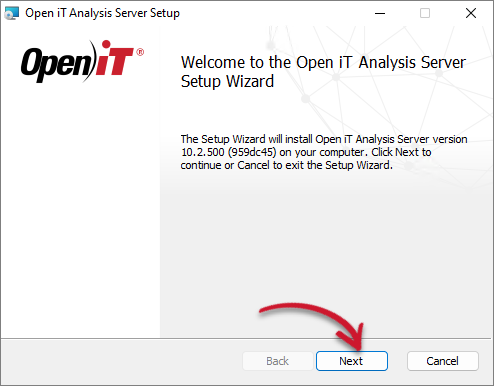 Welcome Screen
Welcome Screen
-
Read the License Agreement before accepting the terms. Click Next.
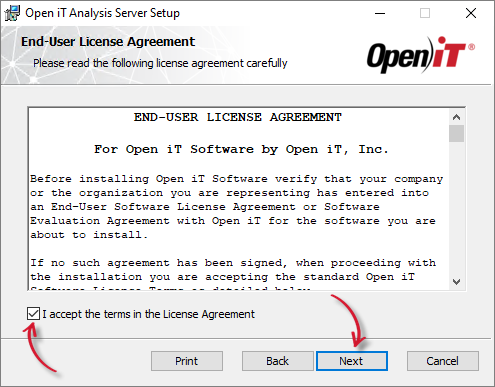 End-user License Agreement
End-user License Agreement
-
Specify where the Open iT software will be installed. Click Change to specify a different directory and click OK. Clicking Next without doing any changes will use the default installation path.
Click Next.
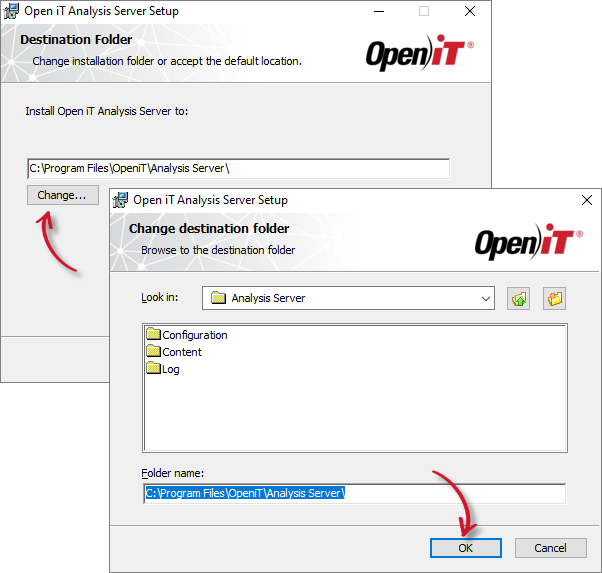 Destination Folder
Destination Folder
-
Specify the TCP/IP port number. This option enables access to the Open iT Analysis Server web application. The default value, 80, may also be used.
Specify the path to a valid Open iT Analysis Server license key. This location may be changed at a later time on the configuration page of the Open iT Analysis Server web interface.
Click Next.
 Web Server TCP Port Number and License File
Web Server TCP Port Number and License File
-
Specify the Service Account User Name and the Password. The user name must include the Active Directory domain. Click Next.
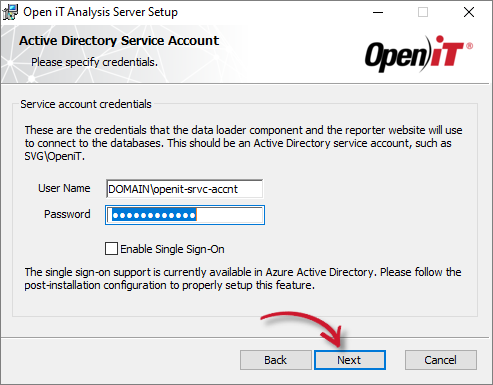 Service Account Credentials
Service Account Credentials
-
Specify the User Group and Administrator Group. Click Next.
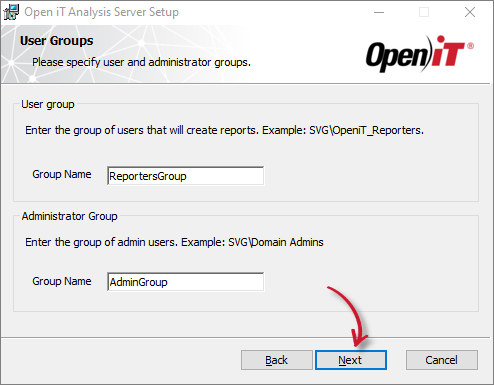 User and Administrator Group
User and Administrator Group
-
Specify the SQL Server Database and instance name where the SQL data warehouse will be created and deployed. Click Browse to look for available SQL Servers on the network.
Specify the SQL Server Analysis Services database and instance name which will hold the reporting cube.
Click Next.
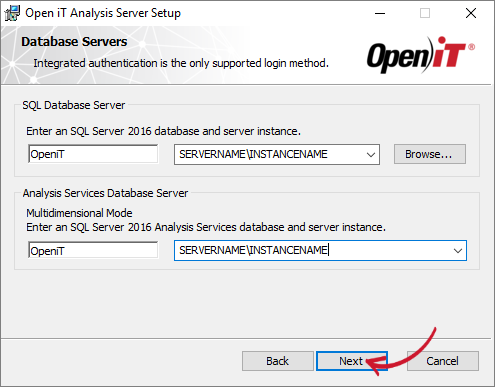 Database Servers
Database Servers
If the installer detects that the SQL Server provided is an Azure SQL Server, another dialog will appear.
This will require you to provide the Azure SQL Server Login credentials pre-created in the server. This is required since the credentials will be used to connect to the server. Make sure that the user has a DBMANAGER server role.
tipFor further details in connecting to Azure SQL Server, please read the article Azure SQL Database Connection Configuration.
Click Next.
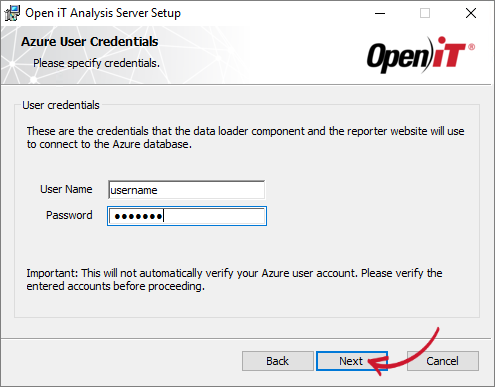 Server Login
Server Login
-
Click Install to start the installation process. If you need to review the entries, click Back.
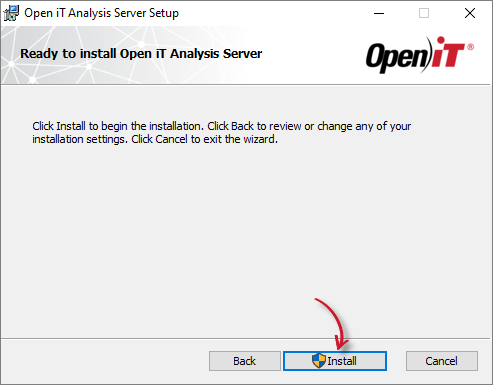 Ready to Install
Ready to Install
-
The installer will set up all necessary files on the computer.
After the installation, a link will be provided for users to access the Open iT Analysis Server Web application. The View Release Notes option can be selected. This option will show a list of updates and fixes included on the installer through a web browser. Deselect this option as needed.
warningYou may experience a delay when viewing the release notes due to the registration process of Analysis Server with Ingress.
Click Finish to complete the installation.
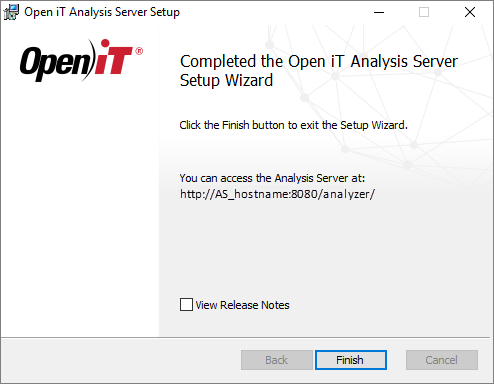 Installation Complete
Installation Complete
Installing through the Command Line
-
Open a command prompt with Administrator level privilege.
-
Execute the following command:
Command Syntaxmsiexec /i <msi_file> /l*v <log_file> <options> LICENSEFILE=<license_file> RUNASUSER=<domain\user> RUNASPASSWORD=<password> REPORTERSGROUP=<group_name> ADMINGROUP=<admingroup_name>Required Parameters:
Parameter Description /i <msi_file>The path of the Windows installer file, openit_<version>_asee_windows_x64.msi.l*v <log_file>The path of the installation log file that will be created during installation. Required Parameters
Optional Parameters:
NOTEThe installer will use the Windows Installer Interface process when the installation option is not specified.
Parameter Description /quietRun the command in silent mode. /passiveRun the command in unattended mode - progress bar only. Optional Parameters
Required Properties:
Properties Description LICENSEFILE=<license_file>The path to the Open iT license file. RUNASUSER=<domain\user>The username, including the Active Directory domain, used as the service account. RUNASPASSWORD=<password>The password of the service account. REPORTERSGROUP=<group_name>The predefined user group with reporting access. ADMINGROUP=<admingroup_name>The predefined user group with administrative rights. Required Properties
Examplemsiexec /i C:\AS_installer\openit_10_2_500_asee_windows_x64.msi /l*v C:\AS_install_logs\AS_logs.txt /quiet LICENSEFILE=C:\AS_license\license RUNASUSER=SVG\admin RUNASPASSWORD=password REPORTERSGROUP=AS_Reporters ADMINGROUP=AS_Admins
Optional Properties:
Use the optional properties to further customize the installation. The default values are used when not specified.
INSTALLDIR=$INSTALL_DIR
The path where the Open iT files will be installed. This value is set toC:\Program Files\OpeniT\Analysis Serverby default.Examplemsiexec /i C:\AS_installer\openit_10_2_500_asee_windows_x64.msi /l*v C:\AS_install_logs\AS_logs.txt /quiet LICENSEFILE=C:\AS_license\license RUNASUSER=SVG\admin RUNASPASSWORD=password REPORTERSGROUP=AS_Reporters ADMINGROUP=AS_Admins INSTALLDIR="C:\OpeniT\Analysis Server\"IISPORTNUMBER=<portnumber>
The TCP/IP port number used by the reporter website. This is set to 80 by default.Examplemsiexec /i C:\AS_installer\openit_10_2_500_asee_windows_x64.msi /l*v C:\AS_install_logs\AS_logs.txt /quiet LICENSEFILE=C:\AS_license\license RUNASUSER=SVG\admin RUNASPASSWORD=password REPORTERSGROUP=AS_Reporters ADMINGROUP=AS_Admins IISPORTNUMBER=8088SQLSERVER=<sqlserver\instance_name>
The SQL Server including the instance name where the SQL database is created.Examplemsiexec /i C:\AS_installer\openit_10_2_500_asee_windows_x64.msi /l*v C:\AS_install_logs\AS_logs.txt /quiet LICENSEFILE=C:\AS_license\license RUNASUSER=SVG\admin RUNASPASSWORD=password REPORTERSGROUP=AS_Reporters ADMINGROUP=AS_Admins SQLSERVER=WIN-HOST02\SQL2019SQLDATABASE=<database_name>
The name of the SQL database.Examplemsiexec /i C:\AS_installer\openit_10_2_500_asee_windows_x64.msi /l*v C:\AS_install_logs\AS_logs.txt /quiet LICENSEFILE=C:\AS_license\license RUNASUSER=SVG\admin RUNASPASSWORD=password REPORTERSGROUP=AS_Reporters ADMINGROUP=AS_Admins SQLDATABASE=OpeniT2022OLAPSERVER=<olapserver\instance_name>
The OLAP (SQL Server Analysis Services) Server including the instance name where the OLAP database is created.Examplemsiexec /i C:\AS_installer\openit_10_2_500_asee_windows_x64.msi /l*v C:\AS_install_logs\AS_logs.txt /quiet LICENSEFILE=C:\AS_license\license RUNASUSER=SVG\admin RUNASPASSWORD=password REPORTERSGROUP=AS_Reporters ADMINGROUP=AS_Admins OLAPSERVER=WIN-HOST02\SQL2019OLAPDATABASE=<database_name>
The name of the OLAP database where the OLAP cubes are created.Examplemsiexec /i C:\AS_installer\openit_10_2_500_asee_windows_x64.msi /l*v C:\AS_install_logs\AS_logs.txt /quiet LICENSEFILE=C:\AS_license\license RUNASUSER=SVG\admin RUNASPASSWORD=password REPORTERSGROUP=AS_Reporters ADMINGROUP=AS_Admins OLAPDATABASE=OpeniT2022TABULARSERVER=<tabularserver\instancename>
The Tabular Server including the instance name where the Tabular database is created.Examplemsiexec /i C:\AS_installer\openit_10_2_500_asee_windows_x64.msi /l*v C:\AS_install_logs\AS_logs.txt /quiet LICENSEFILE=C:\AS_license\license RUNASUSER=SVG\admin RUNASPASSWORD=password REPORTERSGROUP=AS_Reporters ADMINGROUP=AS_Admins TABULARSERVER=WIN-HOST04\SQL2019STABTABULARDATABASE=<databasename>
The name of the Tabular database where the Tabular cubes are created.Examplemsiexec /i C:\AS_installer\openit_10_2_500_asee_windows_x64.msi /l*v C:\AS_install_logs\AS_logs.txt /quiet LICENSEFILE=C:\AS_license\license RUNASUSER=SVG\admin RUNASPASSWORD=password REPORTERSGROUP=AS_Reporters ADMINGROUP=AS_Admins TABULARDATABASE=TabularDbINGRESSURI=<http(s)://hostname:<port_number>>
Specifies the URI used by Ingress to access the web interface.Examplemsiexec /i C:\AS_installer\openit_10_2_500_asee_windows_x64.msi /l*v C:\AS_install_logs\AS_logs.txt /quiet LICENSEFILE=C:\AS_license\license RUNASUSER=SVG\admin RUNASPASSWORD=password REPORTERSGROUP=AS_Reporters ADMINGROUP=AS_Admins INGRESSURI=http://WIN-HOST02:8080/Combine or use optional parameters at the same time to achieve necessary capabilities.
Examplemsiexec /i C:\AS_installer\openit_10_2_500_asee_windows_x64.msi /l*v C:\AS_install_logs\AS_logs.txt /quiet LICENSEFILE=C:\AS_license\license RUNASUSER=SVG\admin RUNASPASSWORD=password REPORTERSGROUP=AS_Reporters ADMINGROUP=AS_Admins INSTALLDIR="C:\OpeniT\AnalysisServer\" IISPORTNUMBER=8088 SQLSERVER=WIN-HOST02\SQL2019 SQLDATABASE=OpeniT2022 OLAPSERVER=WIN-HOST02\SQL2019 OLAPDATABASE=OpeniT2022 TABULARSERVER=WIN-HOST04\SQL2019STAB TABULARDATABASE=TabularDb INGRESSURI=http://WIN-HOST02:8080/ -
When using the passive mode, wait until the process bar dialog disappears. When using the quiet mode, verify if the installation is complete by opening the Task Manager and checking in the Details tab if the msiexec process is still running.
Remote Ingress Setup
Use this guide if Ingress is installed remotely or on a different machine from Analysis Server. This assumes that the Ingress installation is up and running, and the URI is ready.
Installing through the Windows Installer Interface
-
Right-click the
openit_<version>_asee_windows_x64.msiinstaller file, then click Run as Administrator.Allow the app to make changes to the device to begin. A setup wizard will be displayed. Click Next.
 Welcome Screen
Welcome Screen
-
Read the License Agreement before accepting the terms. Click Next.
 End-user License Agreement
End-user License Agreement
-
Specify where the Open iT software will be installed. Click Change to specify a different directory and click OK. Clicking Next without doing any changes will use the default installation path.
Click Next.
 Destination Folder
Destination Folder
-
Specify the TCP/IP port number. This option enables access to the Open iT Analysis Server web application. The default value, 80, may also be used.
Specify the path for a valid Open iT Analysis Server license key. This location may be changed at a later time on the configuration page of the Open iT Analysis Server web interface.
Click Next.
 Web Server TCP Port Number and License File
Web Server TCP Port Number and License File
-
Specify the remote Ingress URI that the Analysis Server will utilize. This will trigger the Analysis Server to establish a connection with Ingress and access the Open iT web application. The default value is http://localhost:27983. Proceed by clicking Next.
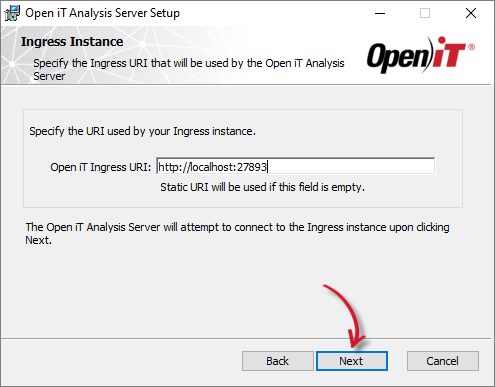 Ingress Instance URI
Ingress Instance URI
If Ingress is not accessible or installed yet, a pop-up warning will appear. Please make sure that the Ingress is installed in the remote machine and accessible. If it still persists, skip by clicking Yes to continue with the installation process.
 Ingress Warning
Ingress Warning
-
Specify the Service Account User Name and the Password. The user name must include the Active Directory domain. Click Next.
 Service Account Credentials
Service Account Credentials
-
Specify the User Group and Administrator Group. Click Next.
 User and Administrator Group
User and Administrator Group
-
Specify the SQL Server Database and instance name where the SQL data warehouse will be created and deployed. Click Browse to look for available SQL Servers on the network.
Specify the SQL Server Analysis Services database and instance name which will hold the reporting cube.
Click Next.
 Database Servers
Database Servers
If the installer detects that the SQL Server provided is an Azure SQL Server, another dialog will appear.
This will require you to provide the Azure SQL Server Login credentials pre-created in the server. This is required since the credentials will be used to connect to the server. Make sure that the user has a DBMANAGER server role.
tipFor further details in connecting to Azure SQL Server, please read the article Azure SQL Database Connection Configuration.
Click Next.
 Server Login
Server Login
-
Click Install to start the installation process. If you need to review the entries, click Back.
 Ready to Install
Ready to Install
-
The installer will set up all necessary files on the computer.
After the installation, a link will be provided for users to access the Open iT Analysis Server Web application. The View Release Notes option can be selected. This option will show a list of updates and fixes included on the installer through a web browser. Deselect this option as needed.
warningYou may experience a delay when viewing the release notes due to the registration process of Analysis Server with Ingress.
Click Finish to complete the installation.
 Installation Complete
Installation Complete
Installing through the Command Line
-
Open a command prompt with Administrator level privilege.
-
Execute the following command:
Command Syntaxmsiexec /i <msi_file> /l*v <log_file> <options> LICENSEFILE=<license_file> RUNASUSER=<domain\user> RUNASPASSWORD=<password> REPORTERSGROUP=<group_name> ADMINGROUP=<admingroup_name>Required Parameters:
Parameter Description /i <msi_file>The path of the Windows installer file, openit_<version>_asee_windows_x64.msi.l*v <log_file>The path of the installation log file that will be created during installation. Required Parameters
Optional Parameters:
NOTEThe installer will use the Windows Installer Interface process when the installation option is not specified.
Parameter Description /quietRun the command in silent mode. /passiveRun the command in unattended mode - progress bar only. Optional Parameters
Required Properties:
Properties Description LICENSEFILE=<license_file>The path to the Open iT license file. RUNASUSER=<domain\user>The username, including the Active Directory domain, used as the service account. RUNASPASSWORD=<password>The password of the service account. REPORTERSGROUP=<group_name>The predefined user group with reporting access. ADMINGROUP=<admingroup_name>The predefined user group with administrative rights. Required Properties
Examplemsiexec /i C:\AS_installer\openit_10_2_500_asee_windows_x64.msi /l*v C:\AS_install_logs\AS_logs.txt /quiet LICENSEFILE=C:\AS_license\license RUNASUSER=SVG\admin RUNASPASSWORD=password REPORTERSGROUP=AS_Reporters ADMINGROUP=AS_Admins
Optional Properties:
Use the optional properties to further customize the installation. The default values are used when not specified.
INSTALLDIR=$INSTALL_DIR
The path where the Open iT files will be installed. This value is set toC:\Program Files\OpeniT\AnalysisServer by default.Examplemsiexec /i C:\AS_installer\openit_10_2_500_asee_windows_x64.msi /l*v C:\AS_install_logs\AS_logs.txt /quiet LICENSEFILE=C:\AS_license\license RUNASUSER=SVG\admin RUNASPASSWORD=password REPORTERSGROUP=AS_Reporters ADMINGROUP=AS_Admins INSTALLDIR="C:\OpeniT\Analysis Server\"IISPORTNUMBER=<portnumber>
The TCP/IP port number used by the reporter website. This is set to 80 by default.Examplemsiexec /i C:\AS_installer\openit_10_2_500_asee_windows_x64.msi /l*v C:\AS_install_logs\AS_logs.txt /quiet LICENSEFILE=C:\AS_license\license RUNASUSER=SVG\admin RUNASPASSWORD=password REPORTERSGROUP=AS_Reporters ADMINGROUP=AS_Admins IISPORTNUMBER=8088SQLSERVER=<sqlserver\instance_name>
The SQL Server including the instance name where the SQL database is created.Examplemsiexec /i C:\AS_installer\openit_10_2_500_asee_windows_x64.msi /l*v C:\AS_install_logs\AS_logs.txt /quiet LICENSEFILE=C:\AS_license\license RUNASUSER=SVG\admin RUNASPASSWORD=password REPORTERSGROUP=AS_Reporters ADMINGROUP=AS_Admins SQLSERVER=WIN-HOST02\SQL2019SQLDATABASE=<database_name>
The name of the SQL database.Examplemsiexec /i C:\AS_installer\openit_10_2_500_asee_windows_x64.msi /l*v C:\AS_install_logs\AS_logs.txt /quiet LICENSEFILE=C:\AS_license\license RUNASUSER=SVG\admin RUNASPASSWORD=password REPORTERSGROUP=AS_Reporters ADMINGROUP=AS_Admins SQLDATABASE=OpeniT2022OLAPSERVER=<olapserver\instance_name>
The OLAP (SQL Server Analysis Services) Server including the instance name where the OLAP database is created.Examplemsiexec /i C:\AS_installer\openit_10_2_500_asee_windows_x64.msi /l*v C:\AS_install_logs\AS_logs.txt /quiet LICENSEFILE=C:\AS_license\license RUNASUSER=SVG\admin RUNASPASSWORD=password REPORTERSGROUP=AS_Reporters ADMINGROUP=AS_Admins OLAPSERVER=WIN-HOST02\SQL2019OLAPDATABASE=<database_name>
The name of the OLAP database where the OLAP cubes are created.Examplemsiexec /i C:\AS_installer\openit_10_2_500_asee_windows_x64.msi /l*v C:\AS_install_logs\AS_logs.txt /quiet LICENSEFILE=C:\AS_license\license RUNASUSER=SVG\admin RUNASPASSWORD=password REPORTERSGROUP=AS_Reporters ADMINGROUP=AS_Admins OLAPDATABASE=OpeniT2022TABULARSERVER=<tabularserver\instancename>
The Tabular Server including the instance name where the Tabular database is created.Examplemsiexec /i C:\AS_installer\openit_10_2_500_asee_windows_x64.msi /l*v C:\AS_install_logs\AS_logs.txt /quiet LICENSEFILE=C:\AS_license\license RUNASUSER=SVG\admin RUNASPASSWORD=password REPORTERSGROUP=AS_Reporters ADMINGROUP=AS_Admins TABULARSERVER=WIN-HOST04\SQL2019STABTABULARDATABASE=<databasename>
The name of the Tabular database where the Tabular cubes are created.Examplemsiexec /i C:\AS_installer\openit_10_2_500_asee_windows_x64.msi /l*v C:\AS_install_logs\AS_logs.txt /quiet LICENSEFILE=C:\AS_license\license RUNASUSER=SVG\admin RUNASPASSWORD=password REPORTERSGROUP=AS_Reporters ADMINGROUP=AS_Admins TABULARDATABASE=TabularDb
Specifies the URI used by Ingress to access the web interface.Examplemsiexec /i C:\AS_installer\openit_10_2_500_asee_windows_x64.msi /l*v C:\AS_install_logs\AS_logs.txt /quiet LICENSEFILE=C:\AS_license\license RUNASUSER=SVG\admin RUNASPASSWORD=password REPORTERSGROUP=AS_Reporters ADMINGROUP=AS_Admins INGRESSURI=http://WIN-HOST02:8080/Combine or use optional parameters at the same time to achieve necessary capabilities.
Examplemsiexec /i C:\AS_installer\openit_10_2_500_asee_windows_x64.msi /l*v C:\AS_install_logs\AS_logs.txt /quiet LICENSEFILE=C:\AS_license\license RUNASUSER=SVG\admin RUNASPASSWORD=password REPORTERSGROUP=AS_Reporters ADMINGROUP=AS_Admins INSTALLDIR=\"C:\OpeniT\AnalysisServer\" IISPORTNUMBER=8088 SQLSERVER=WIN-HOST02\SQL2019 SQLDATABASE=OpeniT2022 OLAPSERVER=WIN-HOST02\SQL2019 OLAPDATABASE=OpeniT2022 TABULARSERVER=WIN-HOST04\SQL2019STAB TABULARDATABASE=TabularDb INGRESSURI=http://WIN-HOST02:8080/ -
When using the passive mode, wait until the process bar dialog disappears. When using the quiet mode, verify if the installation is complete by opening the Task Manager and checking in the Details tab if the msiexec process is still running.
Without Ingress Setup
Use this guide if the Analysis Server will only be standalone and no connection to Ingress will be made. Choose among the installation methods:
Installing through the Windows Installer Interface
-
Right-click the
openit_<version>_asee_windows_x64.msiinstaller file, then click Run as Administrator.Allow the app to make changes to the device to begin. A setup wizard will be displayed. Click Next.
 Welcome Screen
Welcome Screen
-
Read the License Agreement before accepting the terms. Click Next.
 End-user License Agreement
End-user License Agreement
-
Specify where the Open iT software will be installed. Click Change to specify a different directory and click OK. Clicking Next without doing any changes will use the default installation path.
Click Next.
 Destination Folder
Destination Folder
-
Specify the TCP/IP port number. This option enables access to the Open iT Analysis Server web application. The default value, 80, may also be used.
Specify the path to a valid Open iT Analysis Server license key. This location may be changed at a later time on the configuration page of the Open iT Analysis Server web interface.
Click Next.
 Web Server TCP Port Number and License File
Web Server TCP Port Number and License File
-
Skip this dialog since you are installing a standalone Analysis Server (without Ingress). Click Next.
 Ingress Instance URI
Ingress Instance URI
Click Yes to continue with the installation.
 Ingress Warning
Ingress Warning
-
Specify the Service Account User Name and Password. The user name must include the Active Directory domain. Click Next.
 Service Account Credentials
Service Account Credentials
-
Specify the User Group and Administrator Group. Click Next.
 User and Administrator Group
User and Administrator Group
-
Specify the SQL Server Database and instance name where the SQL data warehouse will be created and deployed. Click Browse to look for available SQL Servers on the network.
Specify the SQL Server Analysis Services database and instance name which will hold the reporting cube.
Click Next.
 Database Servers
Database Servers
If the installer detects that the SQL Server provided is an Azure SQL Server, another dialog will appear.
This will require you to provide the Azure SQL Server Login credentials pre-created in the server. This is required since the credentials will be used to connect to the server. Make sure that the user has a DBMANAGER server role.
tipFor further details in connecting to Azure SQL Server, please read the article Azure SQL Database Connection Configuration.
Click Next.
 Server Login
Server Login
-
Click Install to start the installation process. If you need to review the entries, click Back.
 Ready to Install
Ready to Install
-
The installer will set up all necessary files on the computer.
After the installation, a link will be provided for users to access the Open iT Analysis Server Web application. The View Release Notes option can be selected. This option will show a list of updates and fixes included on the installer through a web browser. Deselect this option as needed.
Click Finish to complete the installation.
 Installation Complete
Installation Complete
Installing through the Command Line
-
Open a command prompt with Administrator level privilege.
-
Execute the following command:
Command Syntaxmsiexec /i <msi_file> /l*v <log_file> <options> LICENSEFILE=<license_file> RUNASUSER=<domain\user> RUNASPASSWORD=<password> REPORTERSGROUP=<group_name> ADMINGROUP=<admingroup_name>Required Parameters:
Parameter Description /i <msi_file>The path of the Windows installer file, openit_<version>_asee_windows_x64.msi.l*v <log_file>The path of the installation log file that will be created during installation. Required Parameters
Optional Parameters:
NOTEThe installer will use the Windows Installer Interface process when the installation option is not specified.
Parameter Description /quietRun the command in silent mode. /passiveRun the command in unattended mode - progress bar only. Optional Parameters
Required Properties:
Properties Description LICENSEFILE=<license_file>The path to the Open iT license file. RUNASUSER=<domain\user>The username, including the Active Directory domain, used as the service account. RUNASPASSWORD=<password>The password of the service account. REPORTERSGROUP=<group_name>The predefined user group with reporting access. ADMINGROUP=<admingroup_name>The predefined user group with administrative rights. Required Properties
Examplemsiexec /i C:\AS_installer\openit_10_2_500_asee_windows_x64.msi /l*v C:\AS_install_logs\AS_logs.txt /quiet LICENSEFILE=C:\AS_license\license RUNASUSER=SVG\admin RUNASPASSWORD=password REPORTERSGROUP=AS_Reporters ADMINGROUP=AS_Admins
Optional Properties:
Use the optional properties to further customize the installation. The default values are used when not specified.
INSTALLDIR=$INSTALL_DIR
The path where the Open iT files will be installed. This value is set toC:\Program Files\OpeniT\Analysis Serverby default.Examplemsiexec /i C:\AS_installer\openit_10_2_500_asee_windows_x64.msi /l*v C:\AS_install_logs\AS_logs.txt /quiet LICENSEFILE=C:\AS_license\license RUNASUSER=SVG\admin RUNASPASSWORD=password REPORTERSGROUP=AS_Reporters ADMINGROUP=AS_Admins INSTALLDIR="C:\OpeniT\Analysis Server\"IISPORTNUMBER=<portnumber/>
The TCP/IP port number used by the reporter website. This is set to 80 by default.Examplemsiexec /i C:\AS_installer\openit_10_2_500_asee_windows_x64.msi /l*v C:\AS_install_logs\AS_logs.txt /quiet LICENSEFILE=C:\AS_license\license RUNASUSER=SVG\admin RUNASPASSWORD=password REPORTERSGROUP=AS_Reporters ADMINGROUP=AS_Admins IISPORTNUMBER=8088SQLSERVER=<sqlserver\instance_name>
The SQL Server including the instance name where the SQL database is created.Examplemsiexec /i C:\AS_installer\openit_10_2_500_asee_windows_x64.msi /l*v C:\AS_install_logs\AS_logs.txt /quiet LICENSEFILE=C:\AS_license\license RUNASUSER=SVG\admin RUNASPASSWORD=password REPORTERSGROUP=AS_Reporters ADMINGROUP=AS_Admins SQLSERVER=WIN-HOST02\SQL2019SQLDATABASE=<database_name>
The name of the SQL database.Examplemsiexec /i C:\AS_installer\openit_10_2_500_asee_windows_x64.msi /l*v C:\AS_install_logs\AS_logs.txt /quiet LICENSEFILE=C:\AS_license\license RUNASUSER=SVG\admin RUNASPASSWORD=password REPORTERSGROUP=AS_Reporters ADMINGROUP=AS_Admins SQLDATABASE=OpeniT2022OLAPSERVER=<olapserver\instance_name>
The OLAP (SQL Server Analysis Services) Server including the instance name where the OLAP database is created.Examplemsiexec /i C:\AS_installer\openit_10_2_500_asee_windows_x64.msi /l*v C:\AS_install_logs\AS_logs.txt /quiet LICENSEFILE=C:\AS_license\license RUNASUSER=SVG\admin RUNASPASSWORD=password REPORTERSGROUP=AS_Reporters ADMINGROUP=AS_Admins OLAPSERVER=WIN-HOST02\SQL2019OLAPDATABASE=<database_name>
The name of the OLAP database where the OLAP cubes are created.Examplemsiexec /i C:\AS_installer\openit_10_2_500_asee_windows_x64.msi /l*v C:\AS_install_logs\AS_logs.txt /quiet LICENSEFILE=C:\AS_license\license RUNASUSER=SVG\admin RUNASPASSWORD=password REPORTERSGROUP=AS_Reporters ADMINGROUP=AS_Admins OLAPDATABASE=OpeniT2022TABULARSERVER=<tabularserver\instancename>
The Tabular Server including the instance name where the Tabular database is created.Examplemsiexec /i C:\AS_installer\openit_10_2_500_asee_windows_x64.msi /l*v C:\AS_install_logs\AS_logs.txt /quiet LICENSEFILE=C:\AS_license\license RUNASUSER=SVG\admin RUNASPASSWORD=password REPORTERSGROUP=AS_Reporters ADMINGROUP=AS_Admins TABULARSERVER=WIN-HOST04\SQL2019STABTABULARDATABASE=<databasename>
The name of the Tabular database where the Tabular cubes are created.Examplemsiexec /i C:\AS_installer\openit_10_2_500_asee_windows_x64.msi /l*v C:\AS_install_logs\AS_logs.txt /quiet LICENSEFILE=C:\AS_license\license RUNASUSER=SVG\admin RUNASPASSWORD=password REPORTERSGROUP=AS_Reporters ADMINGROUP=AS_Admins TABULARDATABASE=TabularDbCombine or use optional parameters at the same time to achieve necessary capabilities.
Examplemsiexec /i C:\AS_installer\openit_10_2_500_asee_windows_x64.msi /l*v C:\AS_install_logs\AS_logs.txt /quiet LICENSEFILE=C:\AS_license\license RUNASUSER=SVG\admin RUNASPASSWORD=password REPORTERSGROUP=AS_Reporters ADMINGROUP=AS_Admins INSTALLDIR=\"C:\OpeniT\AnalysisServer\" IISPORTNUMBER=8088 SQLSERVER=WIN-HOST02\SQL2019 SQLDATABASE=OpeniT2022 OLAPSERVER=WIN-HOST02\SQL2019 OLAPDATABASE=OpeniT2022 TABULARSERVER=WIN-HOST04\SQL2019STAB TABULARDATABASE=TabularDb -
When using the passive mode, wait until the process bar dialog disappears. When using the quiet mode, verify if the installation is complete by opening the Task Manager and checking in the Details tab if the msiexec process is still running.
Next Steps?
After an installation, it is recommended to run through all the Installation Verification to verify that the installation is successful.